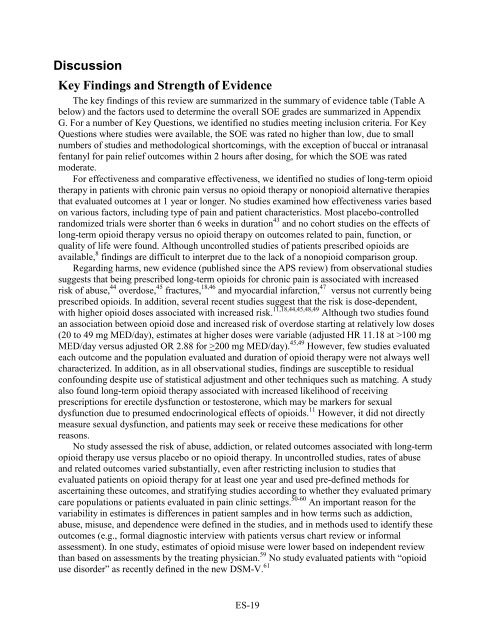chronic-pain-opioid-treatment-report-140929
chronic-pain-opioid-treatment-report-140929
chronic-pain-opioid-treatment-report-140929
You also want an ePaper? Increase the reach of your titles
YUMPU automatically turns print PDFs into web optimized ePapers that Google loves.
DiscussionKey Findings and Strength of EvidenceThe key findings of this review are summarized in the summary of evidence table (Table Abelow) and the factors used to determine the overall SOE grades are summarized in AppendixG. For a number of Key Questions, we identified no studies meeting inclusion criteria. For KeyQuestions where studies were available, the SOE was rated no higher than low, due to smallnumbers of studies and methodological shortcomings, with the exception of buccal or intranasalfentanyl for <strong>pain</strong> relief outcomes within 2 hours after dosing, for which the SOE was ratedmoderate.For effectiveness and comparative effectiveness, we identified no studies of long-term <strong>opioid</strong>therapy in patients with <strong>chronic</strong> <strong>pain</strong> versus no <strong>opioid</strong> therapy or non<strong>opioid</strong> alternative therapiesthat evaluated outcomes at 1 year or longer. No studies examined how effectiveness varies basedon various factors, including type of <strong>pain</strong> and patient characteristics. Most placebo-controlledrandomized trials were shorter than 6 weeks in duration 43 and no cohort studies on the effects oflong-term <strong>opioid</strong> therapy versus no <strong>opioid</strong> therapy on outcomes related to <strong>pain</strong>, function, orquality of life were found. Although uncontrolled studies of patients prescribed <strong>opioid</strong>s areavailable, 8 findings are difficult to interpret due to the lack of a non<strong>opioid</strong> comparison group.Regarding harms, new evidence (published since the APS review) from observational studiessuggests that being prescribed long-term <strong>opioid</strong>s for <strong>chronic</strong> <strong>pain</strong> is associated with increasedrisk of abuse, 44 overdose, 45 fractures, 18,46 and myocardial infarction, 47 versus not currently beingprescribed <strong>opioid</strong>s. In addition, several recent studies suggest that the risk is dose-dependent,with higher <strong>opioid</strong> doses associated with increased risk. 11,18,44,45,48,49 Although two studies foundan association between <strong>opioid</strong> dose and increased risk of overdose starting at relatively low doses(20 to 49 mg MED/day), estimates at higher doses were variable (adjusted HR 11.18 at >100 mgMED/day versus adjusted OR 2.88 for >200 mg MED/day). 45,49 However, few studies evaluatedeach outcome and the population evaluated and duration of <strong>opioid</strong> therapy were not always wellcharacterized. In addition, as in all observational studies, findings are susceptible to residualconfounding despite use of statistical adjustment and other techniques such as matching. A studyalso found long-term <strong>opioid</strong> therapy associated with increased likelihood of receivingprescriptions for erectile dysfunction or testosterone, which may be markers for sexualdysfunction due to presumed endocrinological effects of <strong>opioid</strong>s. 11 However, it did not directlymeasure sexual dysfunction, and patients may seek or receive these medications for otherreasons.No study assessed the risk of abuse, addiction, or related outcomes associated with long-term<strong>opioid</strong> therapy use versus placebo or no <strong>opioid</strong> therapy. In uncontrolled studies, rates of abuseand related outcomes varied substantially, even after restricting inclusion to studies thatevaluated patients on <strong>opioid</strong> therapy for at least one year and used pre-defined methods forascertaining these outcomes, and stratifying studies according to whether they evaluated primarycare populations or patients evaluated in <strong>pain</strong> clinic settings. 50-60 An important reason for thevariability in estimates is differences in patient samples and in how terms such as addiction,abuse, misuse, and dependence were defined in the studies, and in methods used to identify theseoutcomes (e.g., formal diagnostic interview with patients versus chart review or informalassessment). In one study, estimates of <strong>opioid</strong> misuse were lower based on independent reviewthan based on assessments by the treating physician. 59 No study evaluated patients with “<strong>opioid</strong>use disorder” as recently defined in the new DSM-V. 61ES-19


